The 8 Best Running Shoes for Women, Tested and Approved
Dotdash Meredith and Yahoo Inc. may earn commission or revenue on some items through the links below.
Hit the pavement and trails with these best-tested women’s running shoes
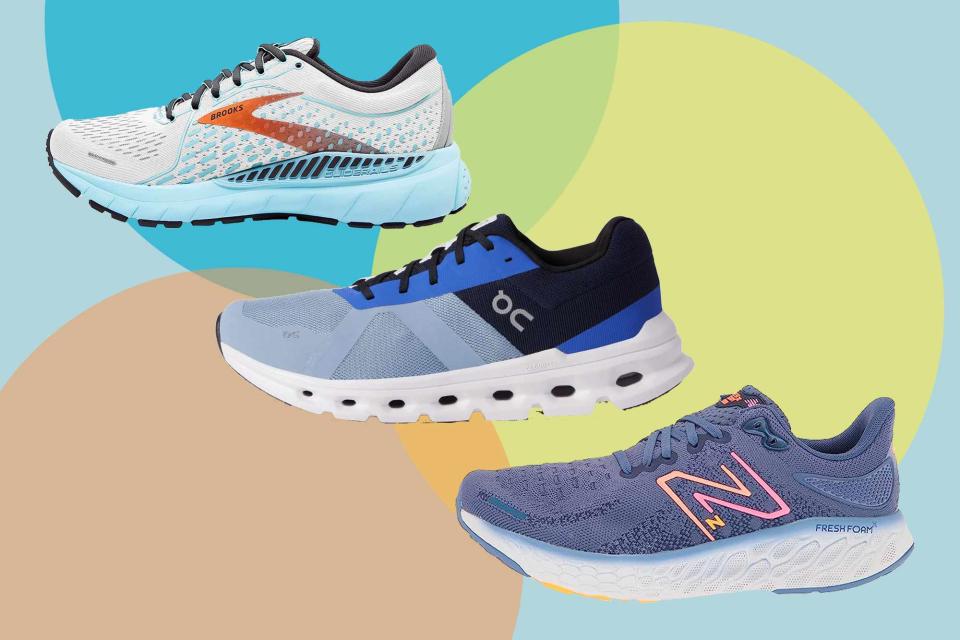
When you hit the road for a run, the last thing you want is the wrong pair of shoes. More than just your average sneakers, a proper pair of running shoes can accompany you through miles of training, providing the necessary support, cushioning, stability and traction to minimize the risk of injuries and enhance performance, says Dr. Bruce Pinker, DPM, a board-certified podiatric foot and ankle surgeon at Progressive Foot Care, in Nanuet, New York. You’re also more likely to enjoy your run in comfortable trainers tailored to your foot and fitness needs.
To help you find the best pair of running shoes, we spoke to podiatric foot and ankle surgeons for their advice and top recommendations for what to look for when shopping. We then put over 90 pairs to the test to evaluate each one for its performance. We logged upwards of 33,000 hours on a variety of surfaces during short and long-distance workouts. We then rated each option according to key areas of fit, cushioning, responsiveness, stability, support and overall value to find our top recommendations.
Our Women’s Running Shoe Recommendations
Best Overall: Brooks Glycerin GTS 20
Best Budget: Brooks Trace 3 Running Shoes
Best Heel Support: AltraFWD
Best for Flat Feet: Brooks Ghost 15
Best for Trail Running: Hoka Speedgoat 5 GTX
Best Stability Running Shoe: Brooks Ghost Max
Best for Strength Training: Nike Free Metcon 5
Best for Arch Support: Hoka Gaviota 5
Best Overall: Brooks Glycerin GTS 20
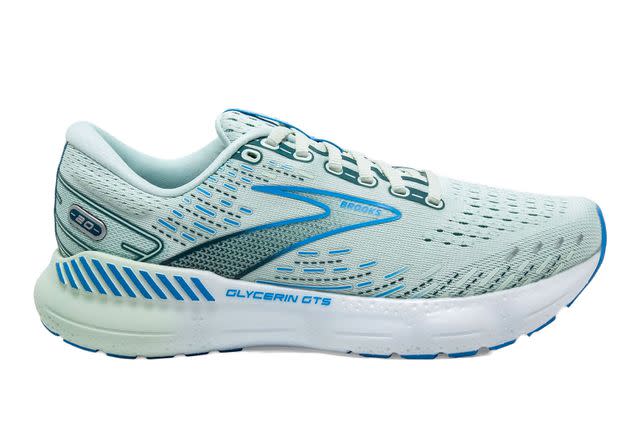
Brooks
What we like: The Glycerin GTS 20 is a versatile shoe with a highly cushioned sole, comfortable support and stable, grippy traction for various activities and terrains.
What to know: While this neutral support shoe will work for most runners, those with extreme overpronation may need an option with more motion control stability, and extreme underpronators (supinators) may need something with a more flexible midsole.
Our best overall pick, Brooks’ Glycerin GTS 20, is a comfortable, versatile shoe with neutral support, stability and cushion. This pair felt great on our test runs, earning perfect scores in all testing categories (fit, cushioning, comfort, responsiveness and stability). What’s more impressive is that it holds an APMA Seal of Acceptance as a running shoe that promotes good foot health and a natural, neutral foot roll.
We love the way the Glycerin GTS fits, effectively cradling every part of the foot. A neutral- to moderate-support running shoe, it has a secure heel counter, a moderately supportive arch and a semi-flexible midsole that’s great for most runners. It features Brooks’ third iteration of its midsole cushioning, DNA Loft v3, which combines EVA foam, rubber, air and nitrogen for a lightweight and responsive cushion to help soften impact and promote quick transitions. This was very noticeable during our tests, as the pair propelled us forward with an energized return at every landing. Despite the high-spring cushion, we loved how these shoes never felt clunky. We also appreciate that they're available in various widths.
Overall, we’d recommend the Glycerin GTS 20 for runners with neutral arches or even those who need mild motion control for overpronation (inward foot roll) and a cushioned sole.
Sizes: 5-12 | Fit: True to size | Available colors: 4 | Cushion level: High | Material: Synthetic upper, rubber outsole
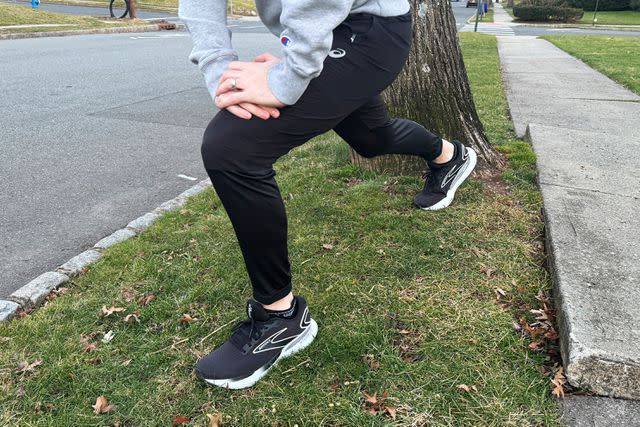
EatingWell / Kimberly Souza
Best Budget: Brooks Trace 3 Running Shoes
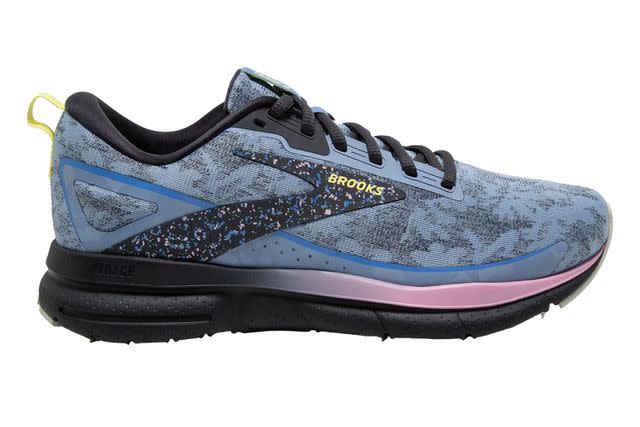
Brooks
What we like: A solid pair of running shoes with an accessible price point and versatility for budget-conscious runners.
What to know: This pair isn’t as cushioned or responsive as other pairs on our list.
If you’re on a budget, Brooks’ Trace 3 is a neutral, supportive daily training shoe with excellent traction and versatility for beginner to intermediate runners. Given its moderate cushioning and stability, this sustainably made shoe is great for runners without any major pronation issues. However, if you suffer from plantar fasciitis or shin splints, you’ll want to consider a more cushioned and supportive option.
We like how the cupped heel counter of this shoe provides a snug, secure hold to prevent shifting (and, in turn, blisters). The traction on this pair is grippy and durable for various surfaces, from treadmills to pavement street running, making this a wallet-friendly and worthy buy if you need a pair of reliable everyday running shoes.
Sizes: 7 to 15 | Fit: True to size | Available colors: 6 | Cushion level: Moderate | Materials: Mesh upper, foam, rubber
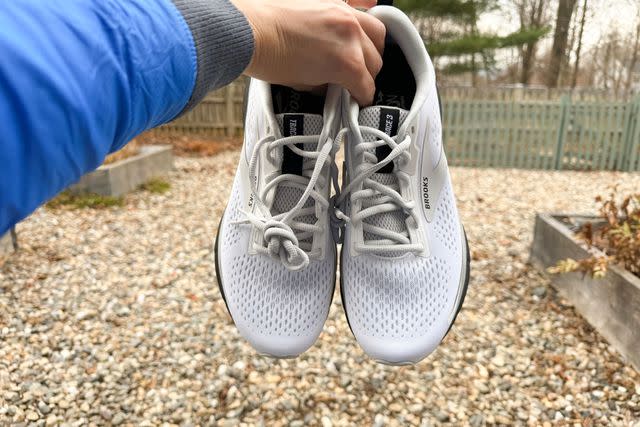
EatingWell / Riddley Schirm
Best Heel Support: AltraFWD
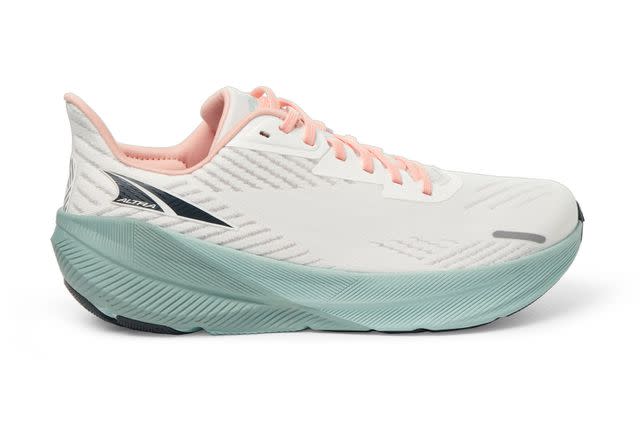
REI
What we like: This comfortable and responsive road-running shoe has excellent Achilles, heel and arch support.
What to know: While the taller back of the ankle collar offers protection and support, it can also irritate the ankles of some runners.
If you need a little extra love in the heel or arch areas, consider Altra’s AltraFWD, which offers a higher level of support than the traditional Altra design. Featuring a flared ankle collar to support the Achilles, their lightweight construction and responsive midsole foam makes them a versatile choice for road running. At the same time, the engineered mesh uppers ensure breathability and a roomy toe box. With a moderate 4-millimeter drop, AltraFWD strikes a balance between the zero-drop shoes Altra is known for with a slightly more elevated heel-to-toe offset and rocker-shaped toe for forward propelling motion and reducing fatigue.
The slightly tall back and tongue did cause slight rubbing during plantar flexion (the pointed toe position after push-off) on our shorter runs. That said, this pair excels in providing a stable, secure feel and Achilles support without sacrificing comfort, even over distances of up to 10 miles. Overall, these shoes offer a great blend of comfort, support and responsiveness, making them an excellent option for beginner and intermediate runners who need more heel and ankle support for daily training.
Sizes: 5.5 to 12 | Fit: True to size | Available colors: 4 | Cushion level: Moderate | Materials: Mesh upper, foam, rubber
Best for Flat Feet: Brooks Ghost 15
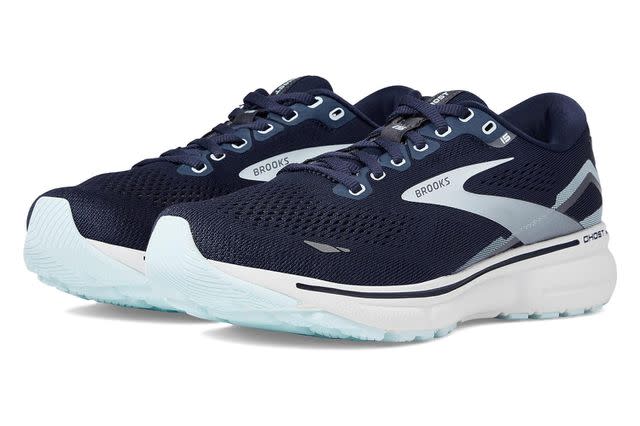
Zappos
What we like: This ultra-comfortable running shoe has a roomy toe box, neutral, stable support and a spacious toe box for natural foot splay—all features that encourage a natural stride in runners with flat feet.
What to know: This shoe has ample but firm cushioning and a stable but wide outsole that makes it feel slightly clunkier than faster shoes on our list.
If you have flat feet, we recommend the Brooks Ghost 15 for its excellent support and neutral stability that help encourage the foot to roll naturally while walking or running. This running shoe staple is now in its 15th generation and features Brooks’ air-infused EVA foam and rubber midsole, DNA Loft v2, for “sweet spot” cushioning that is plush yet nimble enough for most runners. It is slightly wider than the Ghost 14, which makes for better stability, too.
During our tests, we loved how secure and comfortable our feet felt. Designed with a cooling mesh upper and a spacious toe box to allow the feet to splay, we experienced great push-off and maneuverability as we rounded curves and picked up the pace. Additionally, the cushioning and support noticeably relieved our shin splints. At 10 ounces, it’s not the lightest or fastest shoe available, but we found it comfortable, durable and versatile enough for daily workouts.
The Ghost 15 comes in a rainbow of over 33 colors, ten special-edition colorways and wide sizing. Looking for an even plusher ride? Consider the amped-up sole of its sister shoe, the Ghost Max (at Zappos).
Sizes: 5 to 13 | Fit: True to size | Available colors: 30 | Cushion level: High | Materials: Mesh, foam, rubber
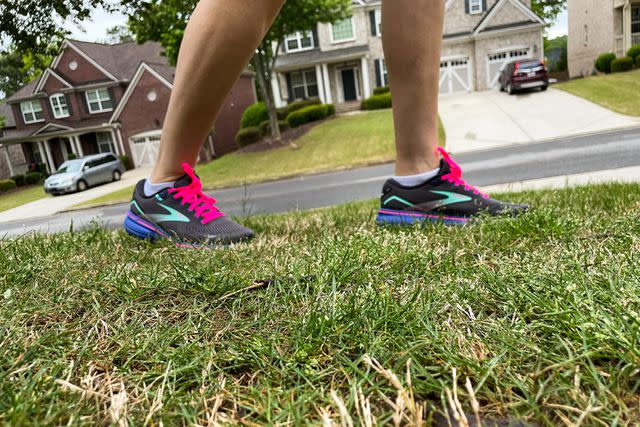
EatingWell / Jessica Fleming
Best for Trail Running: Hoka Speedgoat 5 GTX
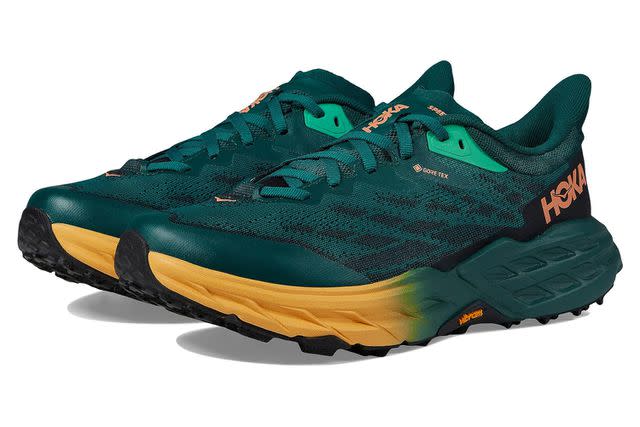
Zappos
What we like: This waterproof trail running shoe provides moderate cushioning, comfortable support and excellent traction for groomed to moderately technical trails.
What to know: Because of their rugged build and waterproofing, these trail shoes are pricier, bulkier and less breathable than your typical running shoe. For a more wallet-friendly option with better ventilation, check out its non-waterproof version, the Hoka Speedgoat 5 (at Zappos).
When hitting the trails, you need a rugged option that still performs comfortably. We recommend the lightweight Hoka’s Speedgoat 5 GTX for its waterproof GORE-TEX lining and comfortable, supportive design. Built with a moderately cushioned, neutrally supportive midsole and contoured insoles, we felt this pair promoted smooth transitions, with each step preparing us for our next stride. Thanks to the secure heel counter, firm cushioning and lower offset, we felt safe and stable in navigating uneven, debris-laden trails.
To put the Speedgoat through its paces, we took this pair onto wet and dry terrain and were impressed by the soft, responsive landing and aggressive performance of the 5-millimeter, cleat-like traction underfoot. Lined with relatively breathable, waterproof GORE-TEX lining and sporting a reinforced rubber toe, our feet felt fully protected no matter the trail condition. With their lightweight, nimble feel, we practically forgot we were wearing these shoes, which allowed us to focus on our stride and enjoy the scenery. They’re sustainably made, easy to clean and made to last for miles of wilderness outings.
Sizes: 7-14 | Fit: True to size | Available colors: 2 | Cushion level: Moderate | Material: Polyester, mesh, EVA foam, rubber
Best Stability Running Shoe: Brooks Ghost Max
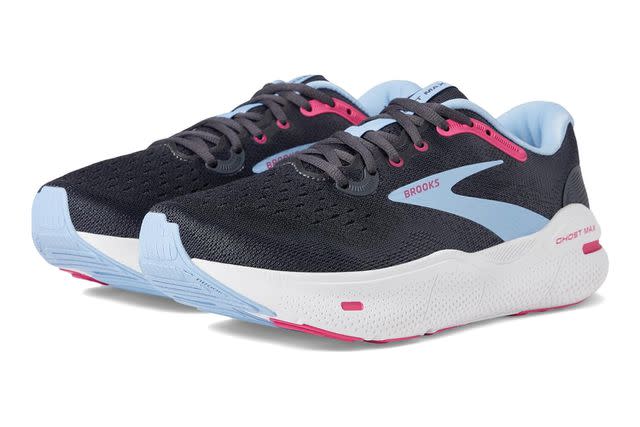
Zappos
What we like: Brooks’ Ghost Max is a stable running shoe with an extra pillowy ride.
What to know: This super-stable, maximum-cushion shoe might feel clunky or less responsive for those wanting a quicker, streamlined option.
With its low 6-millimeter heel drop and wide platform, we recommend Brooks’ Ghost Max for runners needing a stable, impact-protective option. A neutral shoe made with maximum DNA Loft v2 (air-infused foam and rubber) cushioning in the sole, we found the Ghost Max relieved pressure underfoot while promoting a natural stride with smooth heel-to-toe transitions.
The Ghost Max also impressed us with its all-around comfortable, consistent performance. The mesh upper is breathable and snug yet adapts to fit the foot, while the spacious toe box allows for a natural toe splay. Between the pillowy cushioning and comfortable, true-to-size fit, long runs on hard or paved surfaces felt less taxing on the body overall. Available in wide and extra-wide sizes, this shoe has traction best suited for roads, groomed trails and gym use rather than challenging terrain.
We also love that this sustainably-made shoe is certified carbon neutral, meaning the environmental impact of making the shoe is offset by Brooks’ resourcefulness of materials and production methods.
Sizes: 6 to 12 | Fit: True to Size | Available colors: 8 | Cushion level: Maximum | Materials: Mesh, foam, rubber
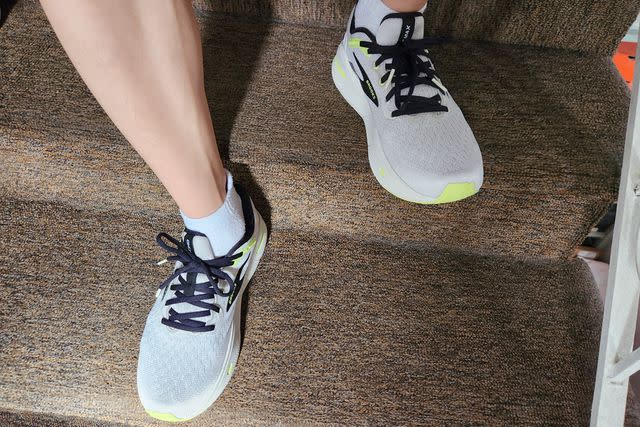
EatingWell / Henry Yung
Best for Strength Training: Nike Free Metcon 5
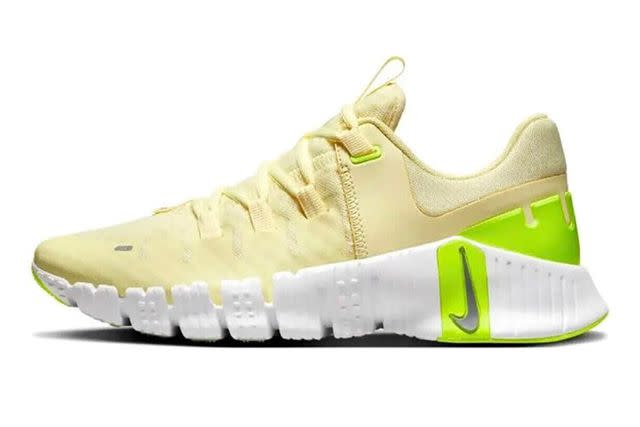
Amazon
What we like: This comfortable cross trainer is stylish, stable and versatile enough for strength training and gym workouts that feature a lot of variation, like CrossFit and HIIT.
What to know: These cross trainers don’t have the cushioning or support for high mileage runs.
If you’re incorporating strength training into your running routine, we highly recommend Nike’s Free Metcon 5. Popular with CrossFitters and gym goers, this supportive, breathable pair excels when your workout involves sprints, HIIT or treadmill workouts. The Metcon 5 has excellent heel cushioning to soften jump landings yet isn’t too overly plush to impede your balance. With its wide base and roomy toe box, this shoe provides exceptional stability and flexibility, encouraging the firm foot placement and toe grip necessary for deadlifts and squats.
Snug yet comfortable enough for all-day wear, the Metcon 5 is lightweight and airy with a second-skin fit and high-lace ankle collar, making it supportive enough for multiplanar movements. However, we'll note that while this pair transitions well between a variety of gym workouts, it’s not meant for high-mileage runs.
Sizes: 6 to 15 | Fit: True to size | Available colors: 11 | Cushion level: Moderate | Materials: Mesh, foam, rubber
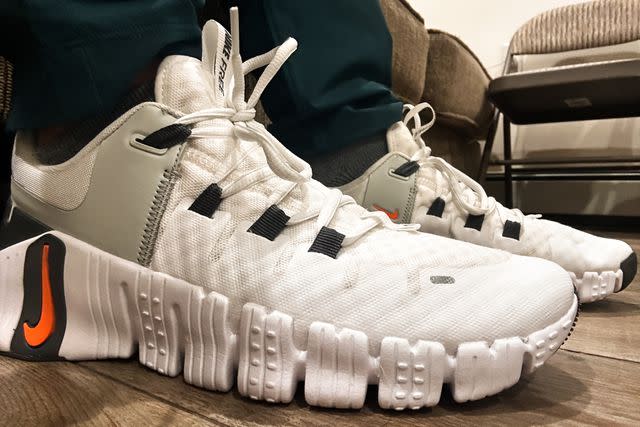
EatingWell / Mike Navarro
Best for Arch Support: Hoka Gaviota 5
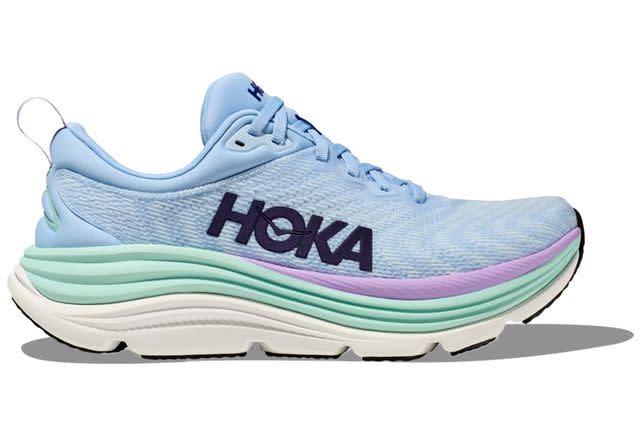
Hoka
What we like: This pair provides a firm base for runners who need additional arch support.
What to know: While stable and supportive, these shoes might not be flexible enough for high-arched underpronators with extreme supination (excessive outward foot roll).
High arches need gentle, cushioned support underfoot, which is why we recommend Hoka’s Gaviota 5. During tests, we found that stability is one of the many areas this shoe excels at. The shoe uses Hoka's signature J-Frame in the midsole, providing dynamic stability that caters to runners with high arches or overpronation. It provides targeted, firm support and shock absorption that helps prevent achy arches and excessive inward rolling, reducing the discomfort and the risk of injuries.
The Gaviota 5’s maximalist midsole features Hoka's renowned EVA foam for a plush, pillowy ride without sacrificing responsiveness. The roomy toe box accommodates natural foot splay, and we found the plush tongue and collar comfortable. The mesh upper feels breathable yet secure to keep the foot further supported.
Sizes: 6 to 11 | Fit: Runs slightly wide | Available colors: 9 | Cushion level: Maximum | Materials: Jacquard mesh upper, foam, rubber
The Bottom Line: The Best Running Shoes for Women
If you're looking for a versatile running shoe that provides excellent shock absorption and neutral support for most runners, Brooks’ Glycerin GTS 20 (view at Amazon) is a comfortable and lightweight option. If you need extra support, we also like Altra’s AltraFWD (view at REI), which provides a locked-in, no-slip heel cradle and supportive ankle collar, and Hoka's Gaviota 5 (view at Zappos) for its comfortable, supportive arches that prevented midfoot pain in our tests.
Choosing Running Shoes for Women
Comfort and Fit Should Come First
Your running shoes should feel like a natural extension of your body, not a hindrance. To minimize the risk of foot or ankle injuries, nail problems or stride issues, your pair must fit properly and comfortably. Pinker recommends that your running shoes snugly fit in width, with approximately 3/8 of an inch (about one centimeter, or half the width of a thumb) between the tip of your longest toe and the inner end of the sneaker. The toe box should offer ample room for your foot and toes to spread out (or splay), aiding in pushing off and propelling yourself forward. Your shoe's heel box should securely hold your foot to prevent excessive movement, while its arch should be comfortably supportive.
Consider Your Support and Stability Needs
Your running shoes should be stable and supportive, but the motion control and support level can vary between foot structures and running styles. Runners with flat feet tend to overpronate (roll inward) during mid-foot roll and usually benefit from the high level of arch support and thicker outsole edges (guide rails) that high-level stability shoes provide for motion control.
Runners who suffer plantar fasciitis or have high arches require extra cushioning and support in the arch and heel areas of their running shoes. High-arched individuals also tend to have feet that supinate, also known as underpronation (an outward rolling). These runners should use neutral stability shoes with a more flexible midsole to encourage a more inward roll, plus cushioned support at the arch and heel to protect from impact. Neutral support running shoes are usually the most versatile among all types of runners unless an individual has extreme pronation issues.
Choose Your Cushioning Level
The level of cushioning you need from your shoes depends on your feet, performance requirements and the surface you’ll be running on. Running shoes generally have more heel, midsole and insole cushioning than your average gym shoes for absorbing impact at the heel and midfoot while running. You can choose from minimal and moderate cushioning for a quick and agile shoe to high and even maximum cushioning for a softer, springier experience. Highly cushioned shoes can also help lessen the likelihood of foot, knee and other leg and hip injuries, especially if you often run on hard surfaces such as pavement or packed dirt, says Pinker.
Cushioning in a shoe can also affect how responsive (or springy) you feel as you land and push off. However, more cushioning in the sole also makes a shoe profile (or stack) taller, which can be a recipe for turning an ankle on uneven terrain. Less-cushioned options sit lower to the ground, making trail running safer.
Look at the Heel-to-Toe Drop
A running shoe’s heel-to-toe drop (or offset) is the difference in height measurement between the heel and the toe and can indicate the level of support, stability and cushioning the shoe has. This measurement can also make a difference in your stride's efficiency and biomechanics, not to mention which part of your foot absorbs the most impact as you run.
Shoes with a higher heel-to-toe drop typically have a more cushioned heel to protect a heel-striking runner from impact and provide a softer landing. Most running shoes fall within the range of 8- to 12-millimeter drop, but some opt for a lower range for a more stable or minimalist shoe experience. A lower heel-to-toe drop can help your stride’s control and balance, especially on uneven terrain, making lower offsets more common in trail running shoes. These shoes have even been shown to place less pressure on the knees and hips, reducing the risk of injury, and can encourage a mid- or forefoot strike. This can mean less impact on the body’s joints. That said, shoes with a low heel-to-toe drop usually take time to get used to, so keep this in mind when choosing a shoe.
Traction Levels Should Fit Your Terrain
Your running shoes should have sufficient traction on various surfaces for safety and performance. Grippy rubber and multidirectional patterns are enough tread for most terrains like asphalt, pavement, gym floors and treadmills. However, running on rugged terrain such as loose dirt, snow, grass, rocks and wet surfaces requires more aggressive, longer lugs (with a tooth-like tread) for a better, safer grip.
Our Women's Running Shoe Tests
To find the best running shoes, we spoke with podiatrists for their advice and recommendations. We tested over 90 pairs of running shoes over a month on roads, trails, treadmills and more. Throughout testing, we evaluated each shoe based on its recommended purpose, whether that be trail running or sprinting. Each pair was rated based on fit, cushioning, responsiveness, support, stability and overall value. Our findings helped us determine which pairs would make our final recommendations for the best running shoes.
We Also Considered
We tested over 90 pairs, but only eight made our top final recommendations for the best running shoes for women. Though they didn’t make our final list, we also considered the following shoes:
ASICS Women's GEL-NIMBUS 25 TR ($110 at Amazon): While these shoes are extremely cushioned and lead to a plush run, they had an excessively long break-in period, which caused our toes to feel “off” until they were more worn in. Because a good pair shouldn’t require much breaking in (if any), we had to overlook this one.
Saucony Triumph RFG ($160 at Zappos): We liked this pair's balanced cushioning and neutral stability but found that the inner curve of the toe box ran narrow, giving us some hot spots on longer runs.
Nike Invincible 3 Women's Road Running Shoes ($180 at Scheels): This shoe felt cushioned and supportive, making it great for those who need more support and shock absorption at the arch. However, this shoe fell short (literally) in the fit of the heel area, which caused Achilles pain, rubbing and slipping of socks.
Common Questions
Are men's and women's running shoes different?
While this can vary considerably by brand, running shoes are often designed with common biomechanical differences between men and women in mind. Women generally have narrower heels and higher arches, whereas men tend to have wider feet. However, these are broad generalizations, and the most important factors to consider are fit and comfort. That's why it's always a good idea to try on a variety of running shoes to find a pair that works best for you.
How long do running shoes last?
Dr. Pinker says that after logging 300 to 500 miles, running shoes lose their impact-protecting cushioning and shock support at the midsole, which can cause injury or pain. If you only run a few miles a week, you can likely get away with only one new pair a year. However, daily runners or long-distance athletes must swap out their shoes more frequently. If you start feeling foot pain or see signs of significant wear and breakdown of the shoe's structure, like the midsole, heel counter, outsole or treads, it’s probably time for a new pair, according to the American Academy of Podiatric Sports Medicine.
How should running shoes fit?
For an enjoyable, injury-free outing, runners should ensure their shoes fit snugly width-wise without feeling hindered because they’re too tight, says Pinker. Use this rule of thumb for length: Account for half a thumb’s width (or one centimeter) of space from the tip of your longest toe to the inside front of the shoe. The heel cradle of the shoe should feel comfortably snug, providing support without constriction. The toe box should also have ample height and width for toes to splay and push off. Your foot shouldn’t feel scrunched up or slide around within your shoe.
Is running a good exercise for health?
While it might not be the most enjoyable workout for everyone, it’s undeniable that running offers several mental and physical health benefits for longevity and well-being. According to the American Heart Association (AHA) and the Centers for Disease Control and Prevention (CDC), adults should aim for at least 150 minutes per week of moderate-intensity aerobic activity, 75 minutes per week of vigorous aerobic activity or a combination of both to maintain a healthy heart. Running is considered a vigorous, highly effective cardiovascular workout for strengthening and improving the heart’s ability to pump blood efficiently, and only 25 minutes three times a week is enough to reduce the risk of heart disease.
Running regularly also helps to lower blood pressure, improve cholesterol levels and help with weight management by burning calories and boosting metabolism, which can help prevent conditions such as type 2 diabetes. A weight-bearing exercise, running also helps to increase and maintain bone density to prevent osteoporosis. Logging some weekly miles can even help you fend off getting sick by making your immune system stronger and more efficient.
Beyond physical health, running can help with your mood, alleviating stress, anxiety and depression by releasing endorphins—the "feel-good" hormones—plus boosting your self-esteem. Exercise also has been shown to enhance cognitive function and memory and promote better sleep and energy.
But while running is generally an excellent exercise for health, Pinker cautions that the impact from running on hard surfaces can lead to greater stress on the lower extremity joints (like the hips, knees, ankles and feet) than lower-impact exercises. Always wear running shoes with enough cushioning and support to absorb the shock of every stride, and opt for a soft running surface, like grass, rubberized track or a treadmill with a shock-absorbing belt whenever possible.
How do I start running for exercise?
If you’d like to add running to your exercise routine, it’s best to ease into it if it’s new to you. First, getting medical clearance is crucial if you have any underlying medical conditions or past injuries, or if you're on any particular medications. Your doctor will help advise whether it’s the best exercise mode for you and if there are any precautions you should take, like carrying a snack if you have type 1 diabetes, wearing a supportive brace to support weak ankles or knees, or wearing a heart rate monitor for those with blood pressure concerns.
After you're cleared to start running, make sure you have comfortable and protective clothes and shoes for the weather, your foot type, running distance and terrain to keep you safely afoot. Warm up properly with a walk or an easy 5- to 10-minute jog and stretch as needed with dynamic (active) stretches to get your body loosened up, which will help prevent injury. Next, begin running gradually, starting with a run/walk method, alternating periods (or intervals) of walking and jogging at a comfortable, conversational pace to build endurance without straining your joints or heart—or feeling miserable the entire time. Start with short distances and add a bit of time to each outing, as tolerated. After you run, cool down with a jog or walk and more stretching to combat sore, stiff muscles.
To reap the full benefits of running, consistency is key. Schedule a regular running routine for a time that works best for you to keep your new habit going.
Our Trusted Expertise
A certified personal trainer and health and fitness writer, Jessica Murtaugh, NASM-CPT and CNC, regularly researches the latest and best in active footwear. An avid runner, she understands how crucial a reliable pair of running shoes is for foot health, safety and performance. She has written dozens of footwear guides for runners, hikers, CrossFitters, gym goers and everyone in between.
For this guide, we consulted New York-based podiatric foot and ankle surgeon Dr. Diana Levin Valencia, DPM, for guidance on how to properly test running shoes. Our writer spoke with Dr. Bruce Pinker, DPM, another podiatric foot and ankle surgeon in New York, for additional recommendations for running shoes for women. Along with their expert advice, insights from the footwear tested in our lab and her expertise as a fitness expert and journalist, Jessica detailed our recommendations. An earlier version of this article was written by Hannah Selinger, an eight-time marathoner, James Beard Award-nominated writer and frequent contributor to EatingWell.
This article was edited by Katie Tuttle, an occasional runner, full-time food editor and contributor to publications such as Food & Wine and The Spruce Eats.
Related: The Best Cold Weather Gear for Running and Walking, According to Our Testers
Read the original article on Eating Well.

